
Giotto's Bell Tower
Encyclopedia
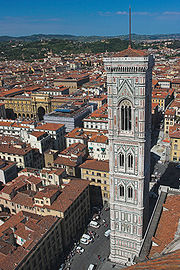
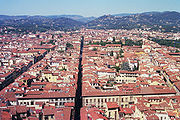
Campanile
Campanile is an Italian word meaning "bell tower" . The term applies to bell towers which are either part of a larger building or free-standing, although in American English, the latter meaning has become prevalent.The most famous campanile is probably the Leaning Tower of Pisa...
that is part of the complex of buildings that make up Florence Cathedral on the Piazza del Duomo
Piazza del Duomo, Florence
Piazza del Duomo is located in the heart of the historic center of Florence, .It is one of the most visited places in Europe and the world; here we can find the Florence Cathedral with the Cupola del Brunelleschi, the Giotto's Campanile, the Florence Baptistery, the Loggia del Bigallo, the Opera...
in Florence
Florence
Florence is the capital city of the Italian region of Tuscany and of the province of Florence. It is the most populous city in Tuscany, with approximately 370,000 inhabitants, expanding to over 1.5 million in the metropolitan area....
, Italy.
Standing adjacent the Basilica
Basilica
The Latin word basilica , was originally used to describe a Roman public building, usually located in the forum of a Roman town. Public basilicas began to appear in Hellenistic cities in the 2nd century BC.The term was also applied to buildings used for religious purposes...
of Santa Maria del Fiore
Santa Maria del Fiore
The Basilica di Santa Maria del Fiore is the cathedral church of Florence, Italy. The Duomo, as it is ordinarily called, was begun in 1296 in the Gothic style to the design of Arnolfo di Cambio and completed structurally in 1436 with the dome engineered by Filippo Brunelleschi...
and the Baptistry of St. John
Battistero di San Giovanni (Florence)
The Florence Baptistry or Battistero di San Giovanni is a religious building in Florence , Italy, which has the status of a minor basilica....
, the tower is one of the showpieces of the Florentine Gothic architecture
Gothic architecture
Gothic architecture is a style of architecture that flourished during the high and late medieval period. It evolved from Romanesque architecture and was succeeded by Renaissance architecture....
with its design by Giotto, its rich sculptural decorations and the polychrome
Polychrome
Polychrome is one of the terms used to describe the use of multiple colors in one entity. It has also been defined as "The practice of decorating architectural elements, sculpture, etc., in a variety of colors." Polychromatic light is composed of a number of different wavelengths...
marble encrustations.
This slender structure stands on a square plan with a side of 14.45 meters (47.41 ft). It attains a height of 84.7 meters (277.9 ft) sustained by four polygonal buttress
Buttress
A buttress is an architectural structure built against or projecting from a wall which serves to support or reinforce the wall...
es at the corners. These four vertical lines are crossed by four horizontal lines, dividing the tower in five levels.
The bells
In Giotto's campanile there are seven bells:- Campanone ("biggest bell"): 1705, diameter 2 m, height 2.10 m, c. 5300 kg, note A2, cast by A. Bruscoli e C. Cenni
- La Misericordia ("mercy bell"): 1670, diameter 1.52 m, 1817 kg, note C3, cast by G.Santoni
- Apostolica: 1957, diameter 1.25 m, 1200 kg, Note D3, cast by P. Barigozzi
- Annunziata: 1956, diameter 1.15 m, 856.5 kg, Note E3, cast by P. Barigozzi
- Mater Dei ("God's Mother bell"), 1956, diameter 95 cm, 481.3 kg, note G3, cast by P. Barigozzi
- L'Assunta, 1956, diameter 85 cm, 339.6 kg, Note A3, cast by P. Barigozzi
- L'Immacolata, 1956, diameter 75 cm, 237.8 kg, Note B3, cast by P. Barigozzi
History

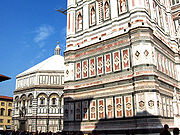
Arnolfo di Cambio
Arnolfo di Cambio was an Italian architect and sculptor.-Biography:Arnolfo was born in Colle Val d'Elsa, Tuscany....
, the first Master of the Works of the Cathedral, and after an interruption of more than thirty years, the celebrated painter Giotto di Bondone
Giotto di Bondone
Giotto di Bondone , better known simply as Giotto, was an Italian painter and architect from Florence in the late Middle Ages...
was nominated as his successor in 1334. At that time he was 67 years old. Giotto concentrated his energy on the design and construction of a campanile (bell tower) for the cathedral. He had become an eminent architect, thanks to the growing autonomy of the architect-designer in relation to the craftsmen since the first half of the 13th century. The first stone was laid on 19 July 1334. His design was in harmony with the polychromy
Polychrome
Polychrome is one of the terms used to describe the use of multiple colors in one entity. It has also been defined as "The practice of decorating architectural elements, sculpture, etc., in a variety of colors." Polychromatic light is composed of a number of different wavelengths...
of the cathedral, as applied by Arnolfo di Cambio, giving the tower a view as if it were “painted”. In his design he also applied chiaroscuro and some form of perspective instead of a strict linear drawing of the campanile. And instead of a filigree
Filigree
Filigree is a delicate kind of jewellery metalwork made with twisted threads usually of gold and silver or stitching of the same curving motifs. It often suggests lace, and in recent centuries remains popular in Indian and other Asian metalwork, and French from 1660 to the late 19th century...
skeleton of a gothic building, he applied a surface of coloured marble in geometric patterns.
When he died in 1337, he had only finished the lower floor with its marble external revetment: geometric patterns of white marble from Carrara
Carrara
Carrara is a city and comune in the province of Massa-Carrara , notable for the white or blue-grey marble quarried there. It is on the Carrione River, some west-northwest of Florence....
, green marble from Prato
Prato
Prato is a city and comune in Tuscany, Italy, the capital of the Province of Prato. The city is situated at the foot of Monte Retaia , the last peak in the Calvana chain. The lowest altitude in the comune is 32 m, near the Cascine di Tavola, and the highest is the peak of Monte Cantagrillo...
and red marble from Siena
Siena
Siena is a city in Tuscany, Italy. It is the capital of the province of Siena.The historic centre of Siena has been declared by UNESCO a World Heritage Site. It is one of the nation's most visited tourist attractions, with over 163,000 international arrivals in 2008...
. This lower floor is decorated on three sides with bas-reliefs in hexagonal panels, seven on each side. When the entrance door was enlarged in 1348, two panels were moved to the empty northern side and only much later, five more panels were commissioned from Luca della Robbia
Luca della Robbia
Luca della Robbia was an Italian sculptor from Florence, noted for his terra-cotta roundels.Luca Della Robbia developed a pottery glaze that made his creations more durable in the outdoors and thus suitable for use on the exterior of buildings. His work is noted for its charm rather than the drama...
in 1437. The number “seven” has a special meaning in Biblical sense: it symbolizes human perfectibility. It is difficult to attribute artistic paternity to these panels, some may be by Giotto himself, the others by Andrea Pisano (or their workshops).
Through this work, Giotto has become, together with Brunelleschi
Filippo Brunelleschi
Filippo Brunelleschi was one of the foremost architects and engineers of the Italian Renaissance. He is perhaps most famous for inventing linear perspective and designing the dome of the Florence Cathedral, but his accomplishments also included bronze artwork, architecture , mathematics,...
(dome of the cathedral of Florence) and Alberti (with his treatise De re aedificatoria, 1450), one of the founding fathers of Italian Renaissance architecture.
Giotto was succeeded as Master of the Works in 1343 by Andrea Pisano
Andrea Pisano
Andrea Pisano , also known as Andrea da Pontedera, was an Italian sculptor and architect.-Biography:Andrea Pisano was born at Pontedera, where he also died....
, famous already for the South Doors of the Baptistery. He continued the construction of the bell tower, scrupulously following Giotto’s design. He added, above the lower level of Giotto, a second fascia, this time decorated with lozenge-shaped panels (1347–1341). He built two more levels, with four niches on each side and each level, but the second row of niches are empty. Construction came to a halt in 1348, year of the disastrous Black Death
Black Death
The Black Death was one of the most devastating pandemics in human history, peaking in Europe between 1348 and 1350. Of several competing theories, the dominant explanation for the Black Death is the plague theory, which attributes the outbreak to the bacterium Yersinia pestis. Thought to have...
.
Pisano was replaced in his turn by Francesco Talenti
Francesco Talenti
Francesco Talenti was a Tuscan architect and sculptor who worked mainly in Florence after 1351. He is mentioned working at Orvieto Cathedral in 1325. In the 1350s he completed the two middle storeys of Giotto's Campanile, and two doorways, the Porta dei Cornacchini and the Porta del Campanile,...
who built the top three levels, with the large windows, completing the bell tower in 1359. He did not build the spire designed by Giotto, thus lowering the designed height of 122 meters (400 ft) to 84.7 meters (277.9 ft) The top, with its breathtaking panorama of Florence and the surrounding hills, can be reached by climbing 414 steps.
Works of art
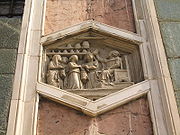
Museo dell'Opera del Duomo (Florence)
The Museo dell'Opera del Duomo in Florence, Italy is a museum containing many of the original works of art created for the Basilica di Santa Maria del Fiore, the cathedral of Florence. The museum is located just east of the Duomo, near its apse...
, behind the cathedral.
The hexagonal panels
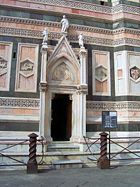
- The creation of man and woman: Creation of Adam, Creation of Eva, Labours of our first parents
- The beginnings of “mechanical arts” and “creative arts” (according to the Bible): Jabal (animal husbandry), Jubal (music, harp and organ), Tubalcain (first blacksmith), Noah (first farmer). This series continues on the south side and the east side of the campanile.
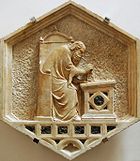
Nino Pisano
thumb|280px|"Euclid", panel from [[Giotto's Bell Tower]], now in the [[Museo dell'Opera del Duomo |Museo dell'Opera del Duomo]], [[Florence]].Nino Pisano thumb|280px|"Euclid", panel from [[Giotto's Bell Tower]], now in the [[Museo dell'Opera del Duomo (Florence)|Museo dell'Opera del Duomo]],...
and “Tubalcain” to an assistant of Andrea Pisano.
The seven hexagonal panels on the south side show us Gionitus (Astronomy), the Art of Building, Medicine, Hunting, Wool-working, Phoroneus (Legislation), Daedalus (flight). They are again attributed to Andrea Pisano, except Gionitus and the Art of Building to his workshop, and Medicine and Phoroneus to Nino Pisano.
The east side only contains five panels, because of the entrance door. They depict the ‘liberal arts’: Navigation, Social Justice, Agriculture, Art of festivals and Euclid (architecture). The first three panels are attributed to Andrea Pisano, while the last two to Nino Pisano. "The Madonna and Child" in the lunette
Lunette
In architecture, a lunette is a half-moon shaped space, either filled with recessed masonry or void. A lunette is formed when a horizontal cornice transects a round-headed arch at the level of the imposts, where the arch springs. If a door is set within a round-headed arch, the space within the...
and the "Two Prophets and the Redeemer" on top of the gable
Gable
A gable is the generally triangular portion of a wall between the edges of a sloping roof. The shape of the gable and how it is detailed depends on the structural system being used and aesthetic concerns. Thus the type of roof enclosing the volume dictates the shape of the gable...
above the entrance door, are both attributed to Andrea Pisano.
The north side hexagonal panels depict: Sculpture, Phidias (both moved to this side from the east side in 1347–1348), Painting, Harmony, Grammar, Logic and Dialectic (represented by Plato and Aristotle), Music and Poetry (represented by Orpheus), Geometry and Arithmetic (represented by Euclid and Pythagoras). The first panel is attributed to Andrea Pisano, the second to Nino Pisano, the others to Luca della Robbia. The last five panels were added after removal of the raised passageway between the campanile and the cathedral.
The lozenges
The lozenges, on the next level, already show a different style: the marble figures stand out on a background of blue majolicaMaiolica
Maiolica is Italian tin-glazed pottery dating from the Renaissance. It is decorated in bright colours on a white background, frequently depicting historical and legendary scenes.-Name:...
. These allegorical representations are almost all attributed to Andrea Pisano or his school:
- West side: The Planets — SaturnSaturnSaturn is the sixth planet from the Sun and the second largest planet in the Solar System, after Jupiter. Saturn is named after the Roman god Saturn, equated to the Greek Cronus , the Babylonian Ninurta and the Hindu Shani. Saturn's astronomical symbol represents the Roman god's sickle.Saturn,...
, JupiterJupiterJupiter is the fifth planet from the Sun and the largest planet within the Solar System. It is a gas giant with mass one-thousandth that of the Sun but is two and a half times the mass of all the other planets in our Solar System combined. Jupiter is classified as a gas giant along with Saturn,...
, MarsMarsMars is the fourth planet from the Sun in the Solar System. The planet is named after the Roman god of war, Mars. It is often described as the "Red Planet", as the iron oxide prevalent on its surface gives it a reddish appearance...
, the SunSunThe Sun is the star at the center of the Solar System. It is almost perfectly spherical and consists of hot plasma interwoven with magnetic fields...
, VenusVenusVenus is the second planet from the Sun, orbiting it every 224.7 Earth days. The planet is named after Venus, the Roman goddess of love and beauty. After the Moon, it is the brightest natural object in the night sky, reaching an apparent magnitude of −4.6, bright enough to cast shadows...
, MercuryMercury (planet)Mercury is the innermost and smallest planet in the Solar System, orbiting the Sun once every 87.969 Earth days. The orbit of Mercury has the highest eccentricity of all the Solar System planets, and it has the smallest axial tilt. It completes three rotations about its axis for every two orbits...
, the MoonMoonThe Moon is Earth's only known natural satellite,There are a number of near-Earth asteroids including 3753 Cruithne that are co-orbital with Earth: their orbits bring them close to Earth for periods of time but then alter in the long term . These are quasi-satellites and not true moons. For more...
. (Venus and Mercury are attributed to Nino Pisano). - South side: The three TheologicalTheological virtuesTheological virtues - in theology and Christian philosophy, are the character qualities associated with salvation, resulting from the grace of God, which enlightens human mind.- In the Bible :The three theological virtues are:...
and four Cardinal VirtuesCardinal virtuesIn Christian traditionthere are 4 cardinal virtues:*Prudence - able to judge between actions with regard to appropriate actions at a given time*Justice - proper moderation between self-interest and the rights and needs of others...
— Faith, Charity, Hope, Prudence, Justice, Temperance, Fortitude (Faith is attributed to Gino Micheli da Castello). - East side: the seven "Liberal ArtsLiberal artsThe term liberal arts refers to those subjects which in classical antiquity were considered essential for a free citizen to study. Grammar, Rhetoric and Logic were the core liberal arts. In medieval times these subjects were extended to include mathematics, geometry, music and astronomy...
" — Astronomy, Music, Geometry, Grammar, Rhetoric, Logic, and Arithmetic. (Geometry and Rhetoric are attributed to Andrea Pisano; the others, except Astronomy, are attributed to Gino Micheli da Castello). - North side: the Seven SacramentsSacraments of the Catholic ChurchThe Sacraments of the Catholic Church are, the Roman Catholic Church teaches, "efficacious signs of grace, instituted by Christ and entrusted to the Church, by which divine life is dispensed to us. The visible rites by which the sacraments are celebrated signify and make present the graces proper...
(represented realistically and not allegorically) — Baptism, Confession, Matrimony, Holy Order, Confirmation, the Eucharist, and the Extreme Unction. They are all attributed to Maso di BancoMaso di BancoMaso di Banco was an Italian painter of the 14th century, who worked in Florence, Italy. He was a pupil of Giotto di Bondone. Maso's name and work are known to us from the autobiography of Lorenzo Ghiberti, I Commentari, which identifies frescoes in the chapel of the Holy Confessors at Santa...
, except Matrimony, attributed to Gino Micheli da Castello.
The statues in the niches

- The four statues on the west side were sculpted by Andrea Pisano and date from 1343. These Gothic statues are rather high-reliefs, left unfinished at the back. They represent the Tiburtine SibylTiburtine SibylThe Tiburtine Sibyl was a Roman sibyl, whose seat was the ancient Etruscan town of Tibur .The mythic meeting of Cæsar Augustus with the Sibyl, of whom he inquired whether he should be worshiped as a god, was a favored motif of Christian artists. Whether the sibyl in question was the Etruscan Sibyl...
, DavidDavidDavid was the second king of the united Kingdom of Israel according to the Hebrew Bible and, according to the Gospels of Matthew and Luke, an ancestor of Jesus Christ through both Saint Joseph and Mary...
, SolomonSolomonSolomon , according to the Book of Kings and the Book of Chronicles, a King of Israel and according to the Talmud one of the 48 prophets, is identified as the son of David, also called Jedidiah in 2 Samuel 12:25, and is described as the third king of the United Monarchy, and the final king before...
and the Erythraean SibylErythraean SibylThe Erythraean Sibyl was the prophetess of classical antiquity presiding over the Apollonian oracle at Erythrae, a town in Ionia opposite Chios, which was built by Neleus, the son of Codrus....
. - The four Prophets on the south side are already more classical in style and date between 1334 and 1341. The statue of Moses and the fourth statue are attributed to Maso di Banco.
- The four Prophets and Patriarchs on the east side date from between 1408 and 1421: the beardless Prophets by DonatelloDonatelloDonato di Niccolò di Betto Bardi , also known as Donatello, was an early Renaissance Italian artist and sculptor from Florence...
(probably a portrait of his friend, the architect Filippo Brunelleschi), the Bearded Prophet (perhaps by Nanni di Bartolo), Abraham and Isaac (by Donatello and Nanni di Bartolo) and Il Pensatore (the thinker) (by Donatello). - The four statues on the north side were added between 1420 and 1435: Prophet (probably by Nanni di Bartolo, however signed by Donatello), HabacucHabakkukHabakkuk , also spelled Habacuc, was a prophet in the Hebrew Bible. The etymology of the name of Habakkuk is not clear. The name is possibly related to the Akkadian khabbaququ, the name of a fragrant plant, or the Hebrew root חבק, meaning "embrace"...
(a masterpiece of Donatello, a tormented and emaciated prophet, portraying Giovanni Chiericini, an enemy of the Medicis), JeremiasJeremiahJeremiah Hebrew:יִרְמְיָה , Modern Hebrew:Yirməyāhū, IPA: jirməˈjaːhu, Tiberian:Yirmĭyahu, Greek:Ἰερεμίας), meaning "Yahweh exalts", or called the "Weeping prophet" was one of the main prophets of the Hebrew Bible...
(by Donatello, portraying Francesco SoderiniFrancesco SoderiniFrancesco di Tommaso Soderini was a major diplomatic and Church figure of Renaissance Italy, and brother of Piero Soderini. He was an adversary of the Medici family....
, another enemy of the Medicis), Abdias (by Nanni di Bartolo).
The three top levels
These levels were built by Francesco Talenti, Master of the Works from 1348 to 1359. Each level is larger than the lower one and extends beyond it in every dimension such that their difference in size exactly counters the effect of perspective. As a result, the top three levels of the tower, when seen from below, look exactly equal in size. The vertical windows open up the walls, a motif borrowed from the Siena campanile. Instead of a spire, Talenti built a large projecting terrace.The reliefs, statues and decoration make a coherent whole when interpreted in terms of medieval scholastic philosophy.
Appearances
The campanile appears in the video game Assassin's Creed IIAssassin's Creed II
Assassin's Creed II is a historical third-person action-adventure video game developed by Ubisoft Montreal and published by Ubisoft for PlayStation 3, Xbox 360, Microsoft Windows and Mac OS X. It is the second video game installment of the Assassin's Creed series, and is a sequel to the 2007 video...
as part of the landscape of Florence. It is possible for the player character to scale the building by jumping from the back of the Duomo (catching a window ledge), and performing a Leap of Faith off a beam jutting out from the ledge of the campanile results in the "High Dive" Xbox 360 achievement or PlayStation 3 trophy.

